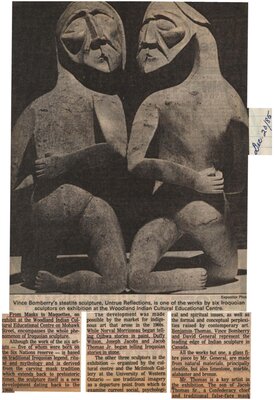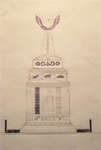"Legend of the Iroquois the Basis for Sculptures"
- Publication
- Brantford Expositor, Winter 1985
- Full Text
- Legend of the Iroquois the basis for sculptures
From Masks to Maquettes, on exhibit at the Woodland Indian Cultural Educational Centre on Mohawk Street, encompasses the whole phenomenon of Iroquoian sculpture.
Although the work of the six artists - five of whom were born on the Six Nations reserve - is based on traditional Iroquoian legend, ritual and mythology and is derived from the carving mask tradition which extends back to prehistoric times, the sculpture itself is a new development dating back to the 1960s.
The development was made possible by the market for indigenous art that arose in the 1960s. While Norval Morrisseau began telling Ojibwa stories in paint, Duffy Wilson, Joseph Jacobs and Jacob Thomas Jr. began telling Iroquoian stories in stone.
The other three sculptors in the exhibition - organized by the cultural centre and the McIntosh Gallery at the University of Western Ontario - use traditional imagery as a departure point from which to examine current social, psychological and spiritual issues, as well as the formal and conceptual perplexities raised by contemporary art. Benjamin Thomas, Vince Bomberry and David General represent the leading edge of Indian sculpture in Canada.
All the works but one, a glass fibre piece by My. General, are made from natural materials, principally steatite, but also limestone, marble, alabaster and bronze.
Mr. Thomas is a key artist in the exhibition. The son of Jacob Thomas Sr., a Confederacy chief and traditional false-face mask carver, he brings to bear on his carving a deep knowledge of Iroquoian history, religion and culture.
He first began carving, not to be exhibited in a gallery but in response to demands of the marketplace. This is his first gallery show.
He is self taught, but a piece such as Tug of War, which depicts a Longhouse ceremonial medicine ritual, is emotionally powerful for its crude, anatomically inaccurate handling of the human figure.
In contrast, Turtle is a decorative piece notable for its economy of design.
Introduced steatiteMr. Wilson, who was born on the Tuscarora Indian reserve, in New York State, is instrumental as the sculptor who introduced steatite to Iroquoian artists. He also was the first to be exposed to the sophisticated Indian art of the southwest United States, and has exhibited at the prestigious Heard Museum, in Phoenix, Ariz.
Mr. Wilson's work is based on traditional legends. A distinguishing characteristic of his sculpture is the predominance of two distinct styles. A highly stylized representational style is found in such works as The Creation Legend and Legend of Ta-da-da-ho. Other works, such as his series of minimalist Eagle sculptures, demonstrate a preoccupation with shape, mass and contour in which legend is expressed through form rather than narrative content.
Mr. Wilson introduced sculpture to Joseph Jacobs, who quickly established himself as the most technically skilled Iroquoian representational sculptor. He was born on the Six Nations reserve, and although he lives in the United States his biggest and most influential shows have been held in Canada.
Works such as The Supernatural Energies of the Birds and Animals and The Timeless Legend of Ta-da-da-ho (described by Woodland museum director Tom Hill as "the height of legend carving") display a highly refined realism which is baroque in its elaborate and intricate design.
Sculptures are literalMr. Jacob's interpretations of legends through sculpture are so literal that the viewer can actually follow storylines by walking around the works, which themselves are so tactile as to compel the viewer to touch the extraordinary texture of the stone.
Mr. Hill noted that, ironically, Mr. Jacobs has refined his art to such a high degree and has established such a reputation that he has been prevented from directing his art into other areas.
Benjamin Thomas' early works reveal a debt to Mr. Jacobs, but it is with the pieces of the last two years - Torn Between Two Lovers, Golden Eagle and As Women Dance - that he asserts his artistic individuality.
The highly decorative minimalist Golden Eagle owes its details of line and texture to pottery of the U.S. southwest.
As Women Dance is an innovative piece with lyrical contours and lines which utilize both mass and space to evoke a highly wrought sensousness.
His latest work, Torn Between Two Lovers, is both captivating and disturbing. The androgynous figure is a powerful metaphor of the contemporary Indian caught between two cultures and value systems, the Indian and non-Indian. The focus is on the lure of personal wealth and the stress its pursuit has placed on traditional ways. The work has intense personal significance for Mr. Thomas, Mr. Hill said. As a faithkeeper of the Longhouse religion, the dilemma facing him as an artist is whether to adhere to the old ways, in which ceremonial objects possess magical-religious powers, or accept the new ways in which artists respond to the pressures of the market place.
Vince Bomberry's intriguing experimental sculpture reveals a fascination with the human form. The powerful juxtaposition of angular lines and twisted contours, the multiple images, strong emotionalism and the rejection of traditional Western conventions of beauty bring to mind Cubist sculpture, which was indebted to primitive African art.
Mr. Bomberry examines and gives shape to psychological implications of Iroquoian mythology through form rather than through content.
Birth of Good and Evil, although derived from the Iroquoian legend of the birth of the primal twins representing good and evil, is imbued with universal significance which transcends cultural boundaries. This is achieved, however, without losing its unique Iroquoian application.
Untrue Reflections, by depicting a figure and its mirror image, suggests such symbolic associations as the conflict between inner and outer, past and present, present and future, and the individual and society.
Although David General's sculpture is based on abstracted human and organic forms, traditional Iroquoian mythology exerts little impact. His preoccupation with architectonic forms derived from nature aligns him more with Henry Moore and Barbara Hepworth than with traditional Iroquoian carvers.
Nevertheless, his concern with the transfer of energy between animate and inanimate objects, imbues his alabaster mask, Moon's Reflections on the Ice, with a mysterious magical charge.
Especially exciting are Mr. Generals maquette groupings, such as The Encampment, which possess the purity of form and spiritual clarity reminiscent of Lawren Harris' monumental Arctic paintings.
Mr. General has now assumed the role performed earlier by sculptors such as Mr. Wilson and Mr. Duffy in opening the eyes of his contemporary artists to the creative possibilities beyond the traditional and the representational.
- Mystery Question
- Who is the author of this article?[Please answer by clicking on the Comments tab]
- Media Type
- Newspaper
- Item Types
- Articles
- Clippings
- Description
- "From Masks to Maquettes, on exhibit at the Woodland Indian Cultural Educational Centre on Mohawk Street, encompasses the whole phenomenon of Iroquoian sculpture."
- Date of Original
- Winter 1985
- Subject(s)
- Personal Name(s)
- Bomberry, Vince, Morrisseau, Norval ; Wilson, Duffy ; Jacobs, Joseph ; Thomas Jr., Jacob ; Thomas, Benjamin ; Thomas Sr., Jacob ; Hill, Tom ; General, David
- Corporate Name(s)
- Woodland Cultural Centre ; University of Western Ontario
- Local identifier
- SNPL002687v00d
- Collection
- Scrapbook #1 by Janet Heaslip
- Geographic Coverage
-
-
Ontario, Canada
Latitude: 43.1668 Longitude: -80.29967
-
- Creative Commons licence
 [more details]
[more details]- Copyright Statement
- Public domain: Copyright has expired according to Canadian law. No restrictions on use.
- Copyright Date
- 1985
- Copyright Holder
- Brantford Expositor
- Contact
- Six Nations Public LibraryEmail:info@snpl.ca
Website:
Agency street/mail address:1679 Chiefswood Rd
PO Box 149
Ohsweken, ON N0A 1M0
519-445-2954



